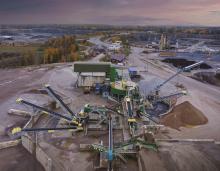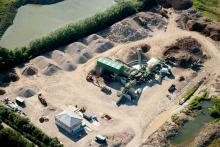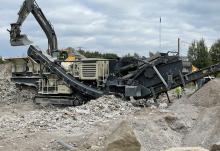
As the construction industry continues to cope with issues around the availability and cost of raw materials, the potential of construction, demolition and excavation (CD&E) waste to address the challenges facing the sector has been highlighted.
CDE, the sand and aggregate wet -processing solutions provider for the natural -processing and waste-recycling sectors, set out the role of its technology in supporting the circular economy and zero-waste agenda at this year's bauma event in Germany (24-30 October).
The company was joined on its stand at the Munich exhibition by a number of its European customers for a series of round table discussions on the future of recycling. One of these was Norway-based sustainability pioneer Tom Wilhelmsen. The company’s waste-management division Massebalanse Norge is shortly set to commission its new CDE waste-recycling plant at Disenå in Norway’s second-largest county, Innlandet.
Tom Wilhelmsen’s CEO Gilberto Enkerlin says that, as part of the company’s sustainability drive, it has changed the way it manages its construction projects and this has not come without challenges .
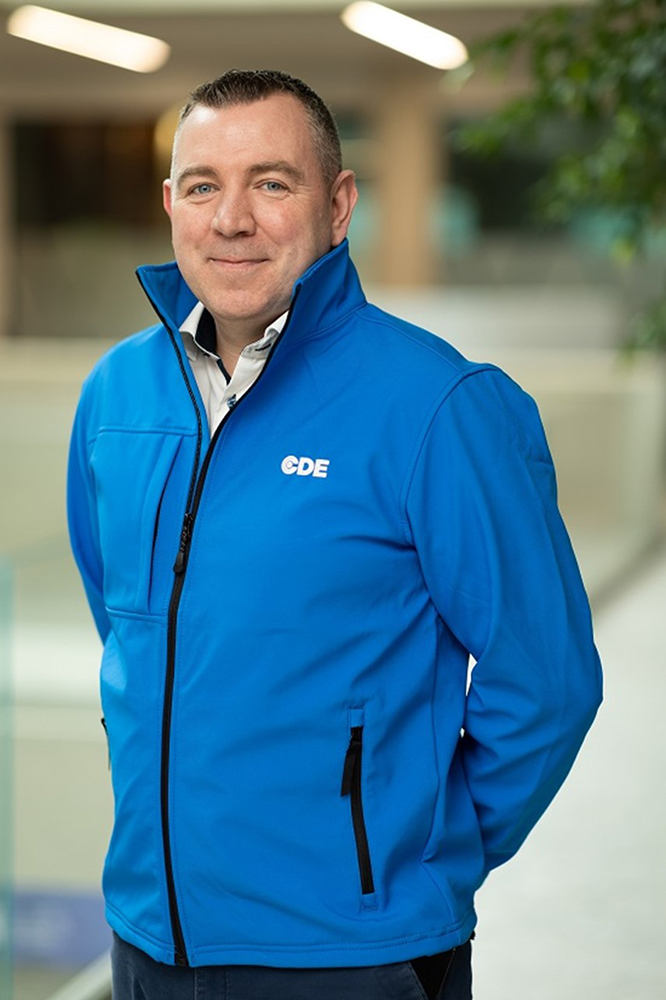
“We have had to find synergies with our partners in order to find [new] ways of doing the same old thing,” he says. “We have done this by establishing one of our sister companies that has a temporary storage solution within the city lines.”
This means the company is able to deposit material within 3-4km of the project that usually went directly to the landfill 30-40km away, and immediately load with aggregate ready for the project.
“The future is here today,” says Enkerlin. “We are implementing the technology daily which is way beyond the scope of what the normal construction companies are implementing. By looking at being a pioneer within the industry we are able to influence the whole construction industry in Norway one step further towards the right direction.”
The company has looked at all stages of its supply chain as part of its sustainability efforts, including quarries and landfills. Because of this , company founder Tom Wilhelmsen selected the CDE recycling plant, which is scheduled to be commissioned by the first quarter of 2023.
CDE's head of business development for North West Europe, Eunan Kelly, observes: "In the current economic and social climate, with materials costs rising, resources depleting, and regulations calling for the adoption of sustainable solutions, we should look to the technology of today to produce the sustainable construction materials of tomorrow; how CDE's waste-recycling solutions in their trademark blue can support the industry to transform CD&E waste into certified, in-spec sand and aggregates."
Earlier this year, a package of European Green Deal proposals was presented with a view to make sustainable products the norm within the EU internal market. The revised Construction Products Regulation (CPR) emphasises the value of construction to the EU as a key employer and economic contributor. However, it also highlights the adverse impacts the sector has on the environment, as one generating some 30% of the EU's annual waste and contributing significantly to its domestic carbon footprint and emissions.
The construction industry is a major economic driver; in the EU alone, 25 million people are employed across five million companies, according to data from the revised CPR. So, when the COVID-19 crisis gripped economies and construction output fell to some of its lowest-ever levels, it was no surprise that robust recovery plans with a clear focus on investments in infrastructure were announced by nations around the world to rebound and stimulate economic growth.
However, the cost of raw materials and their availability remained a deepening challenge for the sector.
Materials shortages and their rising costs are not entirely symptoms of the pandemic, but they have been exacerbated by it and have become more acute, according to CDE's business development manager for the DACH region, Christoph Baier.
"Every day we continue to extract our fast-depleting natural resources to support rapid urbanisation and our modern, technological lifestyles,” says Baier. “Essential to this is sand, the second-most consumed natural resource after water and the most consumed solid material on earth."
In April, the UN Environment Programme (UNEP) published 10 recommendations to avert the impending sand crisis. It referenced how the use of sand, gravel, crushed stone and aggregates has tripled in the last two decades, reaching an estimated 40-50 billion metric tons per year (UNEP 2019).
While COVID-19 economic-recovery packages may help to stimulate growth, Baier says they must be conditional on building back greener, more sustainably.
A circular approach is the only answer, Kelly corroborates.
"It can be the means to equip us with the resources needed to supply a sector charged with a key role in the economic recovery while addressing our collective environmental footprint by reducing waste-to-landfill volumes and extending the lifespan of precious natural materials,” he adds. “All the while continuing to supply a resource-intense sector with the materials it requires; materials often trucked out of our urban centres where they are needed most."
Kelly says the technology needed to extract recycled sand and aggregate resources from CD&E waste that are equivalent to their virgin quarried counterparts is already in operation throughout Europe.
CDE says it supports materials processors to realise the value locked in CD&E waste. Using innovative wet -processing technologies that scrub material, float off lightweights (demolition debris) and classify end products, this waste stream can be repurposed to produce washed materials free of contaminants and suitable for use in high-value construction projects.
To date, CDE solutions have supported companies around the world to divert over 100 million tonnes from landfill.
"These are far from 'alternative' materials," Kelly explains. "Many material processors utilising CDE technology are successfully producing CE- and BSI-certified concrete products, including competitive concrete for non-structural – but still high-value – construction projects, with some applications successfully achieving beyond C45 spec."
DA Mattsson, based near Stockholm in Sweden, diverts almost 100% of its incoming CD&E waste from landfill through its CDE wet-processing operation. The company produces high-quality sand and aggregates that meet EN 12620 specification, and it supplies these concrete materials to the Stockholm construction market.
"We are faced with a myriad of challenges,” Kelly says. “Set against the backdrop of the COVID-19 pandemic and continued rises in the cost of raw materials, these issues have been heightened and highlight the urgent need to radically adjust how we utilise the resources around us in a more circular fashion."
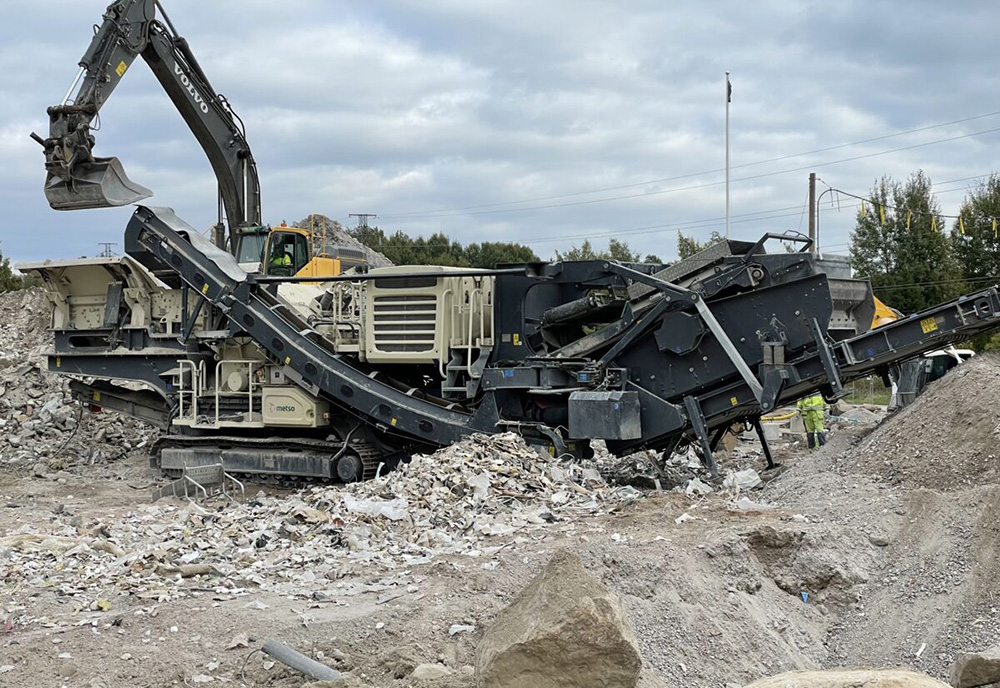
Finland-based aggregates equipment company Metso Outotec is in agreement that there is an imperative need to give new life to construction waste. It says legislations around the world are calling for more recycling of construction and demolition waste, and adds that re-using crushed concrete instead of natural rock and recycling metal saves both the environment and the constructor resources.
Pasi Tulonen, product manager of the Lokotrack contractor line at Metso Outotec, explains that the teardown of structures such as demolished buildings, old roads or bridges creates the opportunity of granting a new life to these materials through recycled aggregates.
“After a selective demolition has taken place, instead of dumping the concrete into a landfill, it is possible to crush the waste material in order to give it a new life,” Tulonen says. “We in Metso Outotec have decades of experience in crushing and screening. We have machines that are designed to process construction waste into re-usable aggregates, these are mobile impact and jaw crushers, as well as mobile screens.”
Tulonen says that using the right crusher, depending on the materials that need to be processed, and sorting them accordingly afterwards are crucial exercises for a successful recycling operation. To succeed in the crushing operation, for instance, it is essential that the units are designed to handle a variety of materials included in the recycled waste while separating the valuable metals with magnetic separator as well as lightweight materials from screened aggregates with a windshifter.
He adds that different products fit better for different types of waste. For instance, if you still have a great mix of materials after crushing, Metso Outotec mobile screens such as Lokotrack ST2.3, ST2.8, Nordtrack S2.5 and S2.11 are ideal for the job, as they are designed to process any type of concrete, asphalt, or slag.
“Our Lokotrack LT1213S mobile impact crusher offers a variety of features for recycling applications and has an integrated screen, which has made it a very popular solution for recycling applications as it provides great results,” says Tulonen.
Metso Outotec customer Joona Ahonen, of Ahosen Palvelut in Finland, comments on its deployment of an LT1213S impactor crusher: “The most important thing for generating profit will be that the machine continues to work with no sudden shutdowns. With the new Lokotrack, we can crush demolition concrete and asphalt, and produce good volumes of clean grades that meet the customers’ needs.”
Swiss-based global building materials and aggregates group Holcim has launched its upgraded 2030 climate targets, validated by the Science Based Targets initiative (SBTi), in line with its sector's new 1.5°C science-based framework. With these upgraded targets, Holcim confirms its commitment to decarbonise building in line with the most advanced science.
Luiz Amaral, CEO of the Science Based Targets initiative, commented on Holcim’s move: “This company is setting an example for the rest of its industry, and I urge others in its sector to set their own targets too."
Jan Jenisch, CEO Holcim, said: "At Holcim, we are committed to decarbonising building for a net-zero future. When I see the thorough decarbonisation plans we are deploying across our business, I am confident that we will decarbonise building at scale.”
In its new 2030 targets, Holcim upgraded its target to reduce scope 1 and 2 emissions per ton of cementitious by 25% by 2030 from a 2018 base year.

